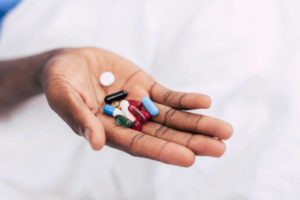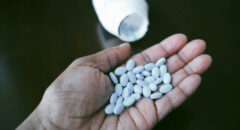 Opioids are natural and synthetic derivatives of opium, a compound produced by the poppy plant. Opium and its derivatives have been used for their medicinal purposes for thousands of years in many different cultures. It is interesting to note that the body produces its own class of chemicals that work in the nervous system the same way the opioids work. Two compounds from opium are morphine and codeine. The compound “morphine” is named after the Greek God Morpheus, the God of dreams. Indeed, morphine and other opioids can produce a euphoric, dream-like state, that can be quite pleasurable. This sensation activates the reinforcement pathways in the brain which drive the desire to seek this experience again. Heroin is another opioid derived from morphine.
Opioids are natural and synthetic derivatives of opium, a compound produced by the poppy plant. Opium and its derivatives have been used for their medicinal purposes for thousands of years in many different cultures. It is interesting to note that the body produces its own class of chemicals that work in the nervous system the same way the opioids work. Two compounds from opium are morphine and codeine. The compound “morphine” is named after the Greek God Morpheus, the God of dreams. Indeed, morphine and other opioids can produce a euphoric, dream-like state, that can be quite pleasurable. This sensation activates the reinforcement pathways in the brain which drive the desire to seek this experience again. Heroin is another opioid derived from morphine.
The opioid drugs have a number of medical uses. These compounds are useful for treating diarrhea. Opium tincture (Paregoric) has been used. The drugs diphenoxylate (a component of Lomotil) and loperamide (Imodium) are opioid-related compounds in over-the-counter anti-diarrhea meds. Opioids also have antitussive or a cough suppressive activity. Codeine is a very effective cough suppressant and it used to be used in over-the-counter cough suppressants. Dextromethorphan is an opioid-related drug used in many over-the-counter cough suppressants.
But one of the most important medical purposes of the opioid drugs is their use as analgesics. They are really the best drugs we have for moderate to severe aches. They are an extremely important class of drugs, but they are a double-edged sword. The opioids used in treating soreness can also produce euphoria, which can activate the reward pathways in the brain that reinforce behaviors and can lead to abuse and addiction (see the previous article that describes the components of addiction). So one challenge in using opioids is to effectively manage discomfort without becoming addicted. For most people, this is not a problem. Most of us have taken opioids for dental procedures, a fracture or sprain, lower backache, surgery, and other medical problems. Our aches were controlled and we didn’t become addicted.
Another problem is that opioids are central nervous system depressants. They can suppress or slow down brain activity. This is very important because, at high doses, opioids can kill. This usually happens when opioids suppress the brain’s control of breathing after a person loses consciousness. So death from an opioid overdose usually occurs from respiratory depression. There are a number of opioid products used for treating discomfort which include morphine, Codeine (combined with Tylenol as Tylenol#3), Oxycodone (combined withTylenol in Percocet), Hydromorphone (Dilaudid), Hydrocodone (combined with Tylenol in Vicodin), to name a few. Fentanil and other related drugs are very potent opioids. While they can provide relief of severe soreness, they can be super deadly when abused because such a small dose produces an effect. The key is to use these drugs as prescribed by medical professionals and they can be used safely.
All the products mentioned so far only provide a few hours of ache relief, whether they are taken by a tablet or administered by injection. So about 20 years ago, companies tried to develop products that provided longer ache relief. This was a very important step in the medical management of soreness.
One product developed was called MS-Contin, a sustained-release preparation of morphine. Another product, Oxycontin is the infamous long-acting version of oxycodone. This product has been linked to the current “opioid crisis”. It’s not clear to me that this product, when used properly, is any more addictive than any other opioid. But when abused, this product supplies a much higher dose of the drug because it contains a quantity of a drug that is designed to be slowly released over time. This could increase the risk of abuse and subsequent addiction.
Heroin is derived from morphine. It is important to understand that there is nothing different or unique about heroin from any other opioid. It is an intravenous, short-acting opioid just like morphine. In many countries, it is a legally available drug and is no more dangerous than any other opioid when used appropriately in a medical setting.
When an opioid like heroin is injected, it produces a very rapid and particularly intense high, more so then if it would be taken orally. So this is one of the reasons the drug is abused this way. It is also why drugs like cocaine and methamphetamine are snorted and smoked. The intense high from injecting the heroin may increase the chance of addiction. When the addicted person tries to stop taking the drug, they experience withdrawal. People whobecome addicted to Oxycontin will quickly switch to heroin which is much more widely available on the street. Withdrawal from some depressant drugs can be very dangerous and even deadly (e.g. alcohol withdrawal).
Opioid withdrawal is not deadly but it is very uncomfortable and the person craves more drug to stop the discomfort. These withdrawal signs and symptoms include severe muscle and stomach cramps, runny nose, sweating, nausea/ diarrhea and agitation from an overactive brain. Remember actor Jamie Foxx in the role of Ray Charles when he withdrew from heroin cold-turkey?
The effects are agonizing. So opioid addicts essentially spend their lives between a zombie-like state where they are subdued by the drug and actively seeking drug to prevent going into withdrawal; a horrible existence. Opioid addicts require more and more drug to produce the same effect. Soon, the dose required to produce a high is close to the amount that can produce an overdose and death.
The common practice of sharing needles between persons injecting heroin and other drugs can result in the transmission of HIV, hepatitis B/hepatitis C, and other blood-borne infections. The residual blood in a syringe after an infected person injects the drug mixes with the heroin when another person uses the same syringe... Addicts are injecting drug multiple times a day and their priority is getting high, not using good hygiene. They may lack money to have access to clean needles. Sharing is generally a good thing, but when it comes to injection drug use; it's NOT! I started this series of articles talking about racial complexities in how we cope with substance abuse.
As I mentioned in a previous article, the medical community had solid scientific evidence for over 20 years showing that distributing clean needles to addicts would reduce the transmission of HIV and viral hepatitis. Yet conservative legislators refused to allow Federal and/or state funds to be used for needle exchange programs…..until 2016. That year, the use of Federal funds was approved for use in needle exchange programs. After all these years having the evidence of the effectiveness of this intervention, why do you think it took so long for the government to finally support it. You get one guess.
In the next article, we will talk about medicines that can be used to control and halt opioid addiction.
 Dr. Crawford has over 25 years of experience in the treatment of HIV. While at Howard University School of Medicine, he worked in two HIV-specialty clinics at Howard University Hospital. He then did clinical research as a visiting scientist with the AIDS Clinical Trials Group (ACTG) at Johns Hopkins University School of Medicine. He served as the Assistant Chief of Public Health Research with the Military HIV Research Program where he managed research studies under the President’s Emergency Plan for AID Relief (PEPFAR) in four African countries.
Dr. Crawford has over 25 years of experience in the treatment of HIV. While at Howard University School of Medicine, he worked in two HIV-specialty clinics at Howard University Hospital. He then did clinical research as a visiting scientist with the AIDS Clinical Trials Group (ACTG) at Johns Hopkins University School of Medicine. He served as the Assistant Chief of Public Health Research with the Military HIV Research Program where he managed research studies under the President’s Emergency Plan for AID Relief (PEPFAR) in four African countries.
He is currently working in the Division of AIDS in the National Institutes of Health. He has published research in the leading infectious diseases journals and serves on the Editorial Board of the journal AIDS. Any views and perspectives in his articles on blackdoctor.org are not representative of any agency or organization but a reflection of his personal views.








